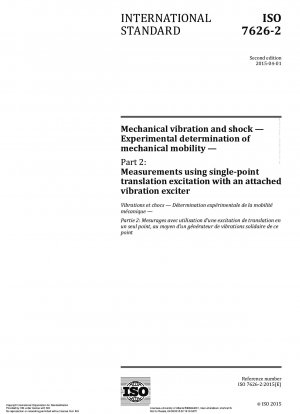ISO 7626-2:2015
Mechanical vibration and shock - Experimental determination of mechanical mobility - Part 2: Measurements using single-point translation excitation with an attached vibration exciter
- Standard No.
- ISO 7626-2:2015
- Release Date
- 2015
- Published By
- International Organization for Standardization (ISO)
- Latest
- ISO 7626-2:2015
- Scope
- This part of ISO 7626 specifies procedures for measuring linear mechanical mobility and other frequencyresponse functions of structures, such as buildings, machines and vehicles, using a single-point translational vibration exciter attached to the structure under test for the duration of the measurement. It is applicable to measurements of mobility, accelerance, or dynamic compliance, either as a drivingpoint measurement or as a transfer measurement. It also applies to the determination of the arithmetic reciprocals of those ratios, such as free effective mass. Although excitation is applied at a single point, there is no limit on the number of points at which simultaneous measurements of the motion response may be made. Multiple-response measurements are required, for example, for modal analyses.
ISO 7626-2:2015 Referenced Document
- ISO 2041:2009 Mechanical vibration, shock and condition monitoring - Vocabulary
- ISO 5348:1998 Mechanical vibration and shock - Mechanical mounting of accelerometers
- ISO 7626-1:2011 Mechanical vibration and shock - Experimental determination of mechanical mobility - Part 1: Basic terms and definitions, and transducer specifications
ISO 7626-2:2015 history
- 2015 ISO 7626-2:2015 Mechanical vibration and shock - Experimental determination of mechanical mobility - Part 2: Measurements using single-point translation excitation with an attached vibration exciter
- 1990 ISO 7626-2:1990 Vibration and shock; experimental determination of mechanical mobility; part 2: measurements using single-point translation excitation with an attached vibration exciter
